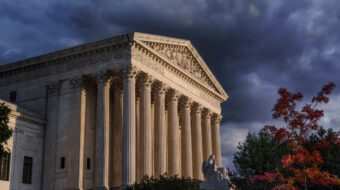Several months ago most pollsters predicted that the margin of difference between Kerry and Bush would be razor thin. I can’t recall anyone projecting a landslide for either candidate, let alone a major political realignment nationwide.
Guess what? They were more right than wrong.
No basic realignment
The outcome wasn’t quite razor thin, but it was no landslide either. Nor did a fundamental political realignment take place. By historical standards, it was a narrow victory. It didn’t remotely approximate the presidential victories in 1940, 1964, 1972, or 1984. Nor did it come close to FDR’s triumphs in the 1930s that ushered in a Democratic majority and realigned national politics for decades to come.
Let’s look at facts: after nearly 120 million votes were cast, the margin of difference separating the two candidates was a mere 3.5 million — 59.8 million for Bush and 56.3 million for Kerry. By any standards that is a close division of the house. Even in the red states, Kerry received 43 percent of the vote and among the main constituencies of the progressive movement — labor, African American, Mexican American, other racially oppressed, women, youth, environmentalists, peace activists, gays and lesbians, and others — he won a clear-cut majority. And had Ohio gone to Kerry, which it nearly did, the soul-searching and hand-wringing would be taking place on the Republican side. To this I would add the historic election to the Senate of African American Barack Obama and Mexican American Ken Salazar, plus other Democratic victories at the congressional and state level.
Only in the states of the old Confederacy can the Republicans legitimately argue that a basic realignment in their favor has taken place, in part because labor is too weak in that region and the Democratic Party and progressive forces on a national level have too easily yielded the South to reaction and racism.
If the contest between Kerry and Bush were a boxing match, Bush would have won a split decision. No knockout punch was delivered on Nov. 2. In fact, the next round of this match between the extreme right and the broad, labor-led democratic movement has already begun.
Less favorable terrain for struggle
Of course, the struggle will not unfold on the terrain that the progressive movement had hoped. While Karl Rove’s stable right-center majority didn’t materialize, the political tilt was enough for the extreme right to recapture the presidency, increase its majority in both houses of Congress, and energize its reactionary base.
Obviously, the dangers in this turn of events are immense. For the Bush administration is not your average bourgeois democratic regime. It is not yet fascist, to be sure, but its personnel, style and policies have all the hallmarks of a conservative-authoritarian government that unhesitatingly sets aside democratic norms, rights and procedures in favor of state-sanctioned lawlessness and use of force.
Why Bush got so many votes
Given the right-wing political coloration of the Bush administration, how do we explain the fact that 58 million people voted for him?
There is no simple answer to this question and it will probably change some as more information becomes available. For now, though, I would offer several reasons.
First of all, the Bush campaign and its powerful propaganda apparatus systematically and unrelentingly exploited the deeply felt anxieties and fears that are traceable to the Sept. 11 terrorist attacks. Sometimes memory of historical events fades overnight, but not the events of Sept. 11. The memory is alive and palpable on both sides of the political divide.
Going door to door in Ashtabula, Ohio, for example, I encountered many people who were concerned about the likelihood of another terrorist attack — not necessarily on the streets of Ashtabula, but on our national soil. Rightly or wrongly, people feel vulnerable and Bush and his propaganda machine heightened this feeling. That they exploited these fears is not surprising. For in the end, they knew that they had to mercilessly manipulate them in order to win.
Another reason for Bush’s victory is that he and his image-makers cleverly and assiduously cultivated the perception that the Republicans were the defenders of family, faith, and life while the Democrats were morally lax, secular-minded, and contemptuous of life, the traditional family and people of faith.
Of course, you must be thinking that the Republican deeds betray their words (and they do), but in politics, perceptions sometimes trump reality. While there is some disagreement over the extent to which moral and cultural issues influenced the election’s outcome, it is fair to say that abortion, gay rights, religion, and moral attitudes loomed considerably larger than in previous elections and that the Republicans were the beneficiaries of this. At the same time, it is very premature to suggest, as some analysts are, that the nation is cleaved down the middle by an immense and unbridgeable cultural divide. There are differences to be sure, but there is plenty of space for both dialogue on cultural concerns and common action on issues of mutual concern, like jobs, health care, education, and the Iraq war.
Economic problems didn’t automatically help Democrats
Another factor that favored Bush is that economic difficulties didn’t automatically translate into Democratic Party votes. For some voters non-material concerns outweighed material ones, while for others, conservative economic ideology kept them in Bush’s camp. The conventional wisdom that Democrats are better economic stewards than their Republican counterparts continues to hold true among a majority of voters, but not to the same extent as it once did.
Bush’s image as a strong leader and homespun man of faith served him well. Though Kerry supporters find this image laughable, Bush’s supporters see him as down-to-earth, straight-talking, able to relate to people, and willing to take decisive action, and this figured into their decision at the voting booth.
Bush also benefited from the systematic suppression of the vote before and on Nov. 2. The extent of voter theft may never be known, but clearly it was consequential and steeped in racism so pervasive, deliberate, and unconcealed that it harkens back to the worst days of Jim Crow. Targeted by the Republican Party were communities of color and especially the African American people.
Finally, the Republicans did a better job turning out their constituency, much to the surprise of many on the other side of the political fence. The prevailing assumption was that the higher the turnout, the greater the likelihood of a Democratic victory. But on this as on other matters, the election went against received wisdom. Compared to 2000, 13 million more voters cast ballots on Election Day, of whom 8 million voted for Bush and only 5 million for Kerry.
GOP’s aggressive apparatus
While no single factor accounts for this advantage in voter turnout, part of the explanation is that the Republican Party is more politically and organizationally coherent than the Democratic Party. For nearly two and a half decades now, the Republicans have been popularizing consistent political themes and an ideological worldview that legitimizes its actions and policies; they have penetrated the mass media, including gaining unchallenged dominance over talk radio and Fox News; they have trained a group of seasoned political operatives and cadre who came of age during the years of Reagan presidency; and they nurtured a grassroots constituency that is “faith-based,” ideologically driven, and dug into rural areas, exurban and new suburban communities.
The Democratic Party has nothing remotely approaching this apparatus. Perhaps it did in the past, but those days are long gone. In fact, were it not for labor, the racially oppressed, women, seniors, youth, peace and environmental organizations, gay and lesbian groups, and new grassroots formations like ACT, MoveOn, True Majority, and many others, the election results would have been much worse.
This loose and many layered coalition of organizations and social forces provided the political muscle for Kerry as well as other Democrats. For months it registered, educated, and organized old and new voters in a variety of creative ways. And on Election Day, its energy and organization brought millions to the polls to vote for Kerry. By every measure, this coalition emerged on Nov. 3 stronger in every sense and more than ready to organize the fight against the Bush agenda in the period ahead.
Need for careful assessments on parties
The political complexity of this election and its outcome has not deterred people of various political persuasions from dissecting the Kerry campaign. While some criticism is warranted, any explanation that exclusively or even mainly fixates on Kerry’s shortcomings is sure to conceal much more than it reveals.
Blame would be better directed at the Democratic Party as a whole. Such criticism is deserved and will undoubtedly be expressed in the election postmortem. And yet despite these sharp critiques, the main class and social forces that utilize the Democratic Party to fight the right and who are critical of it themselves will in all probability continue to operate within its orbit.
For this reason (and other reasons for that matter) abstract appeals to break with the Democratic Party make no tactical sense, especially at this moment when Bush is claiming an election mandate. At a press conference last week, he arrogantly asserted that he had “earned political capital” and intended to spend it.
While millions do not agree with this manifestly self-serving interpretation of the election outcome, Bush and his advisors could care less and will act with great speed. They fully understand that a window of opportunity can close quickly.
Prospects for blocking Bush agenda
The war in Iraq could take a dangerous turn (as it now is), economic conditions could deteriorate, popular movements could hit the streets, or public opinion — which already has grave concerns over the direction in which the country is moving — could quickly sour on the Bush administration’s agenda.
So just as the Bush team is double-timing its preparations for a new offensive at home and abroad, the broad people’s movement must also regroup its forces across the country for an intense period of resistance to that agenda of war, economic hardship, inequality, and attempts to further erode democratic liberties and entitlements. The political soul of our republic hangs in balance.
Blunting the Bush agenda won’t be easy, but it must and can be done. Not for a long time — perhaps never — has the country seen a progressive coalition of this size and scope. While it came up a little short in the effort to defeat Bush, it has the potential to become a center-left majority on a national level. This coalition, which is anchored in the core components of the American people — labor, the racially oppressed and women — possesses a growth curve that is far from exhausted.
With initiative, creativity, and united actions, this coalition can and must deepen and extend its reach to every region of the country (especially the South) and to wider sections of the people. Even among Bush’s current supporters there are different classes and social forces whose interests are contradictory, thereby presenting opportunities for the progressive movement to peel away some of that support.
What is shaping up is a titanic struggle over the future of our country. Each of us has to step forward. As with other turning points in our nation’s history, unity, and especially multiracial unity, must be the watchword and the struggle to defend and extend democracy in all of its forms must be the overriding aim. Only a labor-led united people’s coalition can turn back the right-wing offensive that is spearheaded from the White House.
Sam Webb is the national chairman of the Communist Party USA. He can be reached at swebb@cpusa.org.

MOST POPULAR TODAY


Zionist organizations leading campaign to stop ceasefire resolutions in D.C. area

Communist Karol Cariola elected president of Chile’s legislature

Afghanistan’s socialist years: The promising future killed off by U.S. imperialism

High Court essentially bans demonstrations, freedom of assembly in Deep South





Comments